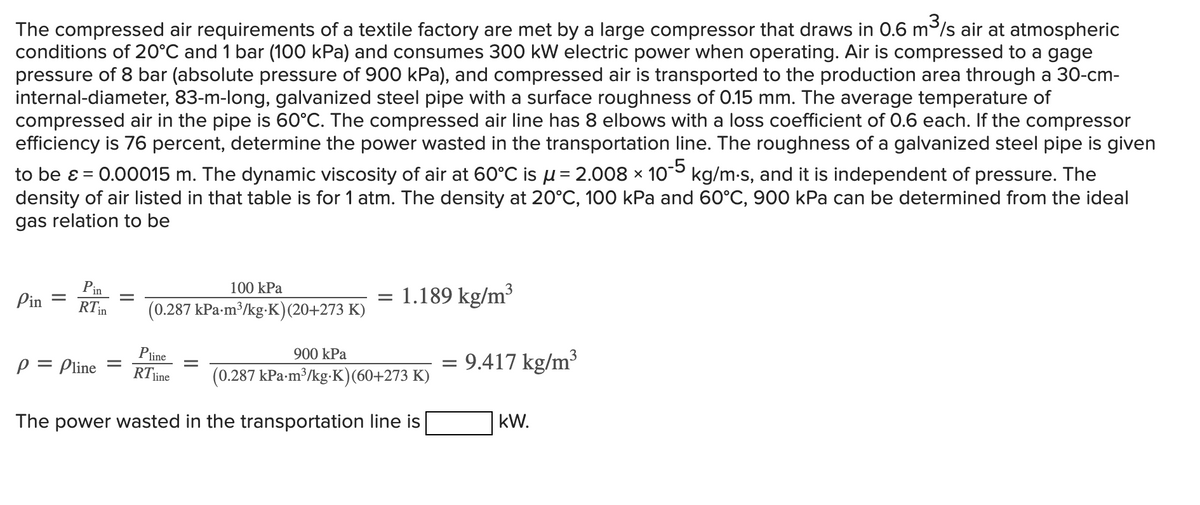The compressed air requirements of a textile factory are met by a large compressor that draws in 0.6 m³/s air at atmospheric conditions of 20°C and 1 bar (100 kPa) and consumes 300 kW electric power when operating. Air is compressed to a gage pressure of 8 bar (absolute pressure of 900 kPa), and compressed air is transported to the production area through a 30-cm- internal-diameter, 83-m-long, galvanized steel pipe with a surface roughness of 0.15 mm. The average temperature of compressed air in the pipe is 60°C. The compressed air line has 8 elbows with a loss coefficient of 0.6 each. If the compressor efficiency is 76 percent, determine the power wasted in the transportation line. The roughness of a galvanized steel pipe is given to be ɛ = 0.00015 m. The dynamic viscosity of air at 60°C is µ = 2.008 × 105 kg/m-s, and it is independent of pressure. The density of air listed in that table is for 1 atm. The density at 2O°C, 100 kPa and 60°C, 900 kPa can be determined from the ideal gas relation to be Pin 100 kPa Pin = = 1.189 kg/m³ RTn (0.287 kPa-m³/kg-K)(20+273 K) Pline p = Pline = 900 kPa 9.417 kg/m³ %3D RTine (0.287 kPa-m³/kg•K)(60+273 K) The power wasted in the transportation line is kW.
The compressed air requirements of a textile factory are met by a large compressor that draws in 0.6 m³/s air at atmospheric conditions of 20°C and 1 bar (100 kPa) and consumes 300 kW electric power when operating. Air is compressed to a gage pressure of 8 bar (absolute pressure of 900 kPa), and compressed air is transported to the production area through a 30-cm- internal-diameter, 83-m-long, galvanized steel pipe with a surface roughness of 0.15 mm. The average temperature of compressed air in the pipe is 60°C. The compressed air line has 8 elbows with a loss coefficient of 0.6 each. If the compressor efficiency is 76 percent, determine the power wasted in the transportation line. The roughness of a galvanized steel pipe is given to be ɛ = 0.00015 m. The dynamic viscosity of air at 60°C is µ = 2.008 × 105 kg/m-s, and it is independent of pressure. The density of air listed in that table is for 1 atm. The density at 2O°C, 100 kPa and 60°C, 900 kPa can be determined from the ideal gas relation to be Pin 100 kPa Pin = = 1.189 kg/m³ RTn (0.287 kPa-m³/kg-K)(20+273 K) Pline p = Pline = 900 kPa 9.417 kg/m³ %3D RTine (0.287 kPa-m³/kg•K)(60+273 K) The power wasted in the transportation line is kW.
Elements Of Electromagnetics
7th Edition
ISBN:9780190698614
Author:Sadiku, Matthew N. O.
Publisher:Sadiku, Matthew N. O.
ChapterMA: Math Assessment
Section: Chapter Questions
Problem 1.1MA
Related questions
Question

Transcribed Image Text:The compressed air requirements of a textile factory are met by a large compressor that draws in 0.6 m/s air at atmospheric
conditions of 20°C and 1 bar (100 kPa) and consumes 300 kW electric power when operating. Air is compressed to a gage
pressure of 8 bar (absolute pressure of 900 kPa), and compressed air is transported to the production area through a 30-cm-
internal-diameter, 83-m-long, galvanized steel pipe with a surface roughness of 0.15 mm. The average temperature of
compressed air in the pipe is 60°C. The compressed air line has 8 elbows with a loss coefficient of 0.6 each. If the compressor
efficiency is 76 percent, determine the power wasted in the transportation line. The roughness of a galvanized steel pipe is given
to be ɛ = 0.00015 m. The dynamic viscosity of air at 60°C is u= 2.008 x 10° kg/m-s, and it is independent of pressure. The
density of air listed in that table is for 1 atm. The density at 20°C, 100 kPa and 60°C, 900 kPa can be determined from the ideal
gas relation to be
Pin
100 kPa
Pin
= 1.189 kg/m³
3
(0.287 kPa-m³/kg-K)(20+273 K)
Pline
900 kPa
p = Pline
= 9.417 kg/m³
RT
line
(0.287 kPa-m³/kg-K)(60+273 K)
The power wasted in the transportation line is
kW.
Expert Solution
This question has been solved!
Explore an expertly crafted, step-by-step solution for a thorough understanding of key concepts.
This is a popular solution!
Trending now
This is a popular solution!
Step by step
Solved in 6 steps

Knowledge Booster
Learn more about
Need a deep-dive on the concept behind this application? Look no further. Learn more about this topic, mechanical-engineering and related others by exploring similar questions and additional content below.Recommended textbooks for you

Elements Of Electromagnetics
Mechanical Engineering
ISBN:
9780190698614
Author:
Sadiku, Matthew N. O.
Publisher:
Oxford University Press

Mechanics of Materials (10th Edition)
Mechanical Engineering
ISBN:
9780134319650
Author:
Russell C. Hibbeler
Publisher:
PEARSON

Thermodynamics: An Engineering Approach
Mechanical Engineering
ISBN:
9781259822674
Author:
Yunus A. Cengel Dr., Michael A. Boles
Publisher:
McGraw-Hill Education

Elements Of Electromagnetics
Mechanical Engineering
ISBN:
9780190698614
Author:
Sadiku, Matthew N. O.
Publisher:
Oxford University Press

Mechanics of Materials (10th Edition)
Mechanical Engineering
ISBN:
9780134319650
Author:
Russell C. Hibbeler
Publisher:
PEARSON

Thermodynamics: An Engineering Approach
Mechanical Engineering
ISBN:
9781259822674
Author:
Yunus A. Cengel Dr., Michael A. Boles
Publisher:
McGraw-Hill Education

Control Systems Engineering
Mechanical Engineering
ISBN:
9781118170519
Author:
Norman S. Nise
Publisher:
WILEY

Mechanics of Materials (MindTap Course List)
Mechanical Engineering
ISBN:
9781337093347
Author:
Barry J. Goodno, James M. Gere
Publisher:
Cengage Learning

Engineering Mechanics: Statics
Mechanical Engineering
ISBN:
9781118807330
Author:
James L. Meriam, L. G. Kraige, J. N. Bolton
Publisher:
WILEY